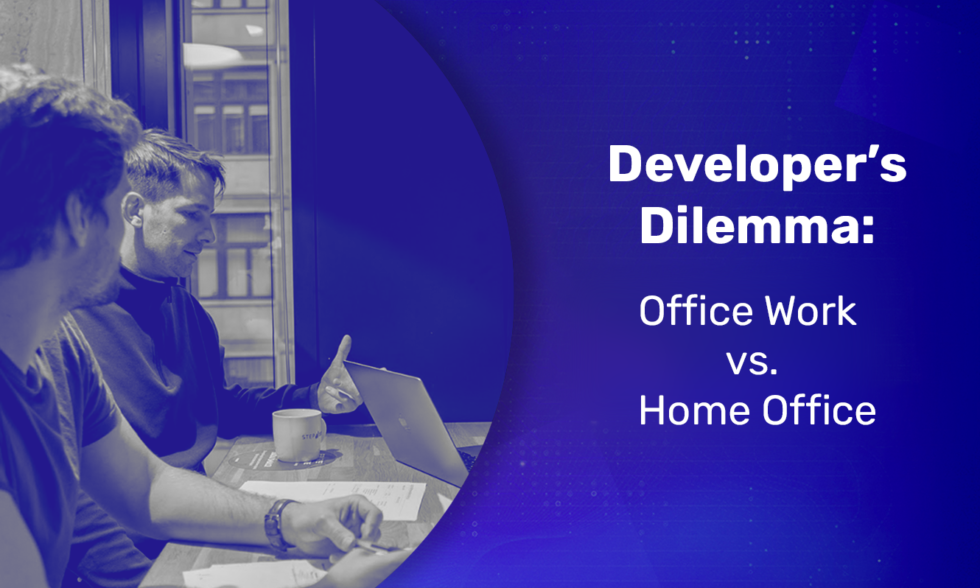Few months ago I was trolling LinkedIn with my survey asking how much time we should be working from home. This question was probably asked a million times on that platform over the last two years. Though over 1 000 professionals have answered my survey (sic!). This gave me an idea for the article and a unique occasion to share with you, what is the best for developers to work efficiently and creatively – office or home office.
What the pandemic has demonstrated to us is that people really like to work remotely. Before coronavirus most of the bosses couldn’t imagine letting anyone work from home. Suddenly they were forced to turn on a dime, and free literally every employee to work in their own home offices. It turns out that people can work from home, and they can stay as productive as they were in the classic office environment. Sometimes they become even more efficient! Does it mean that from now on every developer should work remotely? I think it doesn’t, and I am not alone in this approach.
Let’s check “remote working” data!
PwC’s US Remote Work Survey indicated that 83% of employers say the shift to remote work has been successful for their company. Other research from GitLab confirmed that 82% of workers believe that remote work is the future. The same studies have shown the disconnection between the ostensibly high levels of satisfaction with remote work and the actual pain people are feeling day-to-day in home offices. This could be a reason why 42% of responders will take a hybrid approach after covid.
McKinsey’s survey of office space managers in the USA found that after the pandemic, they expect a 36% increase in work time outside their offices. Last but not least, 85% of working adults from the UK wanted to use a “hybrid” approach of both home and office working in the future.In the analysis of the effects of the coronavirus pandemic on office working they also stated work-life balance was the greatest positive, while challenges of collaboration were the greatest negative.
Work in the office vs. home office
I’m glad we have learned how to appreciate home office. After the pandemic of coronavirus started I have turned one of my rooms into a cosy office and I really enjoy working there. During the day I can go for a run or play with my daughter. Home office has many more pros for me.
Despite what I just wrote, there are still many benefits of showing up in the office once in a while. In my case, 2 to 3 times a week, but for the other developer it could shape differently. Stepwise is well aware of this. That is why in our company we use hybrid work solutions and our staff is able to adjust time and place of work according to the current needs of the project and the specific person.
You probably heard that coming to the office might be good for people’s well-being or that it’s easier to distinguish work time from private time. There are other benefits for programmers that go far beyond that.
When I joined Stepwise I noticed that despite the pandemic, there were still a good number of programmers showing up in the office. This was a great time to discuss the project, a new framework, and even politics or football (during a lunch break of course if the boss asks).
In person, we are able to discuss in depth a single line of code, during a code review and get multiple points of view. Five or six developers (junior to senior) can go deep into project architecture and discuss why a specific solution is better (or worse) to use.
Office work is much better, when you want to do a substantive review. I remember one time we talked in our company about monorepo for a specific project, and the other time we brainstormed how to introduce SCRUM in clients’ projects properly. Totally spontaneous. Communication was much easier, and always every one of us could draw something on the board (E.g. issue too hard to explain by words), while others would give necessary feedback.
These kinds of discussions let us learn new skills from fellow developers. This kind of interaction is super hard to have online (we tried). For me video chats and video conferences are less engaging. When one of us talks, the others are usually muted, so brainstorming is hard and a lot of good ideas don’t float to the surface. Project reviews and workshops become less spontaneous and just less fun.
I’m not advocating to bring back the “good old days”, when everyone was in the office so the boss could see them working. Much more flexible style of work surely benefited me, and most people I talk to think the same. Although we’re not only starting to miss some human interactions, we also get fewer opportunities for discovering new and exciting ideas with our colleagues.
Hybrid solutions in Stepwise
Stepwise in every project values both efficiency and creativity equally. If you want to be the best software house you have to look after the client’s, but also the developer’s sake. For that reason in Stepwise we are using hybrid work solutions. Our developers are able to adjust time and place of work, first and foremost according to the current needs of the project, and secondly of course to their own needs. This approach has been successful for a long time. This is confirmed by satisfied employees and clients in their testimonials on the Clutch.




